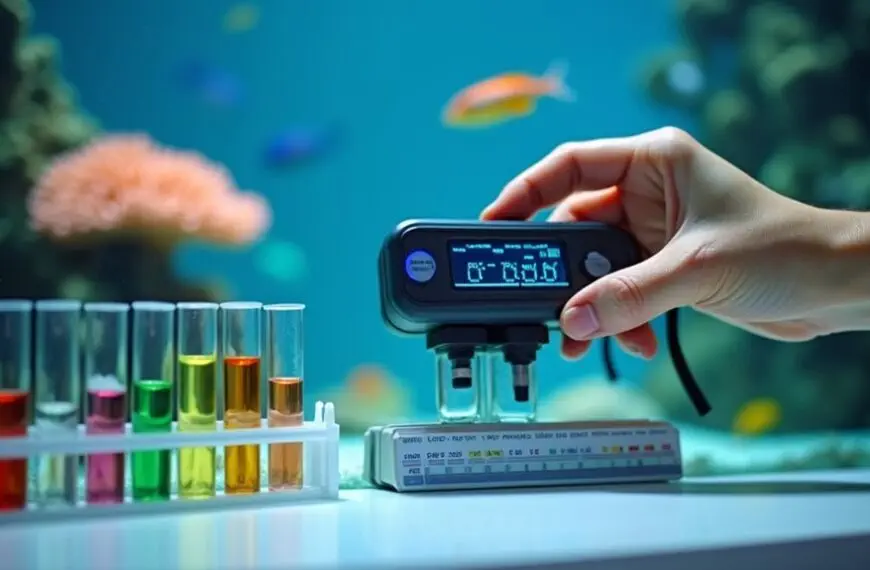Testing your fish tank water quality is super important to keep your finned friends happy and healthy! Regular checks help you spot harmful toxins like ammonia and nitrite that can stress out your fish. You wouldn't want to live in a messy room, right? Well, your fish feel the same! Keeping an eye on pH levels also helps create a chill environment for them. Plus, by monitoring these factors, you can prevent diseases and keep your aquarium thriving. It's like a wellness check for your aquatic pals! Stick around, and you'll discover more tips to keep your tank in tip-top shape!
Contents
- 1 Importance of Regular Testing
- 2 Understanding Key Water Parameters
- 3 Effects of Poor Water Quality
- 4 Methods for Testing Water Quality
- 5 Frequency of Water Testing
- 6 Managing Ammonia and Nitrite Levels
- 7 Maintaining Ph and Hardness
- 8 Role of Filtration in Water Quality
- 9 Addressing Algal Growth Issues
- 10 Community Resources and Support
- 11 Frequently Asked Questions
- 12 Final Thoughts
Importance of Regular Testing
Regular testing of your fish tank water quality is crucial for maintaining a healthy environment for your aquatic pets. Without regular checks, harmful toxins like ammonia can sneak up on you, posing serious risks to your fish. You don't want those little swimmers gasping for air because their home has turned into a toxic soup!
Monitoring pH levels is just as important. If your tank's pH fluctuates outside the safe range of 6.5 to 7.5, your fish could become stressed or worse. Think of it as their version of a bad hair day—it's not pretty!
During the cycling process of a new tank, testing weekly can save you from ammonia spikes that could be catastrophic. Understanding the Nitrogen Cycle helps you cultivate beneficial bacteria, ensuring waste is managed efficiently.
This is key to achieving balanced water quality, and it's like giving your fish a spa day every day.
Understanding Key Water Parameters
To keep your fish healthy, you need to grasp the key water parameters that influence their environment. These elements play a crucial role in ensuring your aquatic friends thrive in their cozy home.
Let's break it down:
- Ammonia: This toxic compound should always be at 0 ppm. Even a tiny bit can make your fish feel like they're swimming in a toxic soup!
- Nitrite Levels: Just like ammonia, nitrite should also be at 0 ppm to keep your fish safe and happy.
- Nitrate: Aim for levels below 20 ppm. Higher concentrations can cause stress, turning your vibrant tank into a not-so-happy place.
- pH: Most tropical fish love a pH between 6.5 and 7.5. Fluctuations can be like a rollercoaster ride for them—exciting for you, but not so much for your fish!
Regularly checking these water parameters will help you create a supportive environment for your fish.
Think of it as a way to show your love and dedication—because who doesn't want their fish to feel like royalty in their underwater kingdom?
Effects of Poor Water Quality

When your fish tank water quality drops, it can really take a toll on your fish's health.
Poor water conditions can lead to increased stress, making your finned friends more vulnerable to diseases like ich or fin rot—yikes!
Keeping a close eye on your water parameters isn't just a chore; it's the key to ensuring your aquatic buddies stay happy and healthy.
Fish Health Decline
Poor water quality can seriously impact fish health, leading to a decline in their overall well-being. When you neglect to check your aquarium's water, you risk exposing your fish to harmful levels of ammonia and nitrite. This can cause respiratory distress and even death.
Here are some effects of poor water quality you should keep in mind:
- Stressful Environments: Elevated nitrate levels above 50 ppm can stress your fish, making them more vulnerable to illness.
- Behavior Changes: Fluctuations in pH can make your fish act strangely or become lethargic.
- Weakened Immunity: Overcrowded or poorly maintained tanks can weaken fish immune systems, leading to more frequent illness.
- Oxygen Depletion: Harmful contaminants like chlorine can create algae blooms, robbing your fish of oxygen.
Increased Disease Risk
Maintaining a healthy aquarium is crucial, as poor water quality significantly increases the risk of disease among your fish. When you let ammonia and nitrite levels spike, you're inviting stress and illness into your underwater paradise.
Ammonia should sit at a safe level of 0 ppm; anything higher can lead to serious respiratory issues or even fin rot. That's no fun for your fish friends!
Elevated nitrate levels above 50 ppm can also wreak havoc, weakening your fish's immune systems. When they're stressed, they're more likely to fall victim to diseases like ich or fin rot.
You might notice your fish swimming erratically or being unusually lethargic—these are signs they're feeling the pressure of poor water quality.
Methods for Testing Water Quality
When it comes to testing your fish tank water, you've got several handy tools at your disposal.
From easy-to-use test strips to more advanced liquid kits and electronic meters, each method has its perks, depending on how serious you're about your aquatic friends.
And remember, keeping an eye on your water's quality isn't just a one-and-done task; seasonal changes might mean you need to test more often, so stay on your game!
Testing Tools Overview
To ensure your fish tank thrives, having the right tools for testing water quality is essential. You want to provide a safe and healthy environment for your aquatic friends, and the right testing tools make all the difference.
Here's an overview of some handy options:
- Test Strips: Quick and user-friendly, these strips help you assess basic parameters like pH and ammonia levels in a snap.
- Liquid Test Kits: For those seeking accuracy, these kits mix water samples with reagents, giving you precise readings on nitrite and nitrate—it's like a chemistry experiment in your kitchen!
- Electronic Meters: These handy gadgets offer instant readings for pH and conductivity, but remember, they need regular calibration to keep them in top shape.
- Professional Lab Services: When you're serious about your fish, sending samples to a lab can reveal complex details about trace elements and contaminants, ensuring your tank's water is pristine.
Frequency of Testing
Regular testing of your fish tank water quality is crucial for keeping your aquatic environment healthy and stable. For new aquariums, you should test your ammonia, nitrite, and nitrate levels daily during the cycling process. This ensures your fish have a safe place to thrive.
Once your tank is established, testing every 2-4 weeks will usually suffice, but don't get too comfortable! If you notice any signs of illness or unusual behavior in your fish, increase your testing frequency. Quick checks can help you catch potential water quality issues before they escalate.
It's also wise to test after any water changes, introducing new fish, or making environmental adjustments. After all, you're the guardian of your aquatic friends!
Seasonal changes can affect water parameters, so keep an eye out for fluctuations as well. Depending on your needs and budget, you can choose various testing methods—like test strips for quick checks, liquid kits for accuracy, or electronic meters for instant readings.
Parameter Importance Explained
Understanding water parameters is essential for maintaining a thriving fish tank. Without regular monitoring, your aquatic friends might face unnecessary stress or health issues. Testing water quality isn't just a chore; it's a loving commitment to your fish!
Here are four key parameters you should always keep an eye on:
- Ammonia: Aim for 0 ppm; higher levels can be toxic.
- Nitrite: Like ammonia, it should also be at 0 ppm.
- Nitrate: Keep this low for a healthy aquarium.
- pH Level: Ideally between 6.5 and 7.5 for most freshwater fish.
You can use test strips for a quick check, or if you're feeling extra precise, opt for liquid test kits that showcase those stunning color changes.
Electronic meters can provide instant readings but keep in mind they may cost a bit more.
Frequency of Water Testing

When setting up a new aquarium, daily testing for ammonia and nitrite levels is crucial during the cycling process to create a safe environment for your fish.
Think of it as a fishy health check-up! Once your tank is established, you can ease up a bit and test every 2-4 weeks for nitrate levels. This keeps your water quality in check and helps maintain fish health without turning into a full-time job.
If your fish start acting strangely or show signs of illness, don't wait—test the water immediately. It's better to catch potential problems early.
For outdoor ponds, aim to test 3-4 times a year, particularly during seasonal changes. Fish can be sensitive to these shifts, and you want to keep their home comfy.
Keep an eye on environmental changes, too. If you're adding new fish or if evaporation is occurring, it's wise to increase your testing frequency.
You're not just a fish keeper; you're a fish guardian! By regularly monitoring your water quality, you're ensuring your aquatic friends swim happily in a safe and healthy environment.
Managing Ammonia and Nitrite Levels
Monitoring ammonia and nitrite levels is vital for maintaining a healthy aquarium. These substances can wreak havoc on your fish's well-being. Keeping both ammonia and nitrite at 0 ppm is key to preventing fish stress and ensuring great water quality.
Here's how you can manage these levels effectively:
- Test regularly: Weekly testing helps you catch harmful spikes early, especially in new tanks.
- Feed wisely: Overfeeding leads to elevated ammonia levels. Your fish don't need a buffet every day!
- Maintain your tank: Ensure proper filtration and do regular water changes to keep everything in check.
- Use beneficial bacteria: These little helpers can break down ammonia and nitrite, promoting a healthier environment.
Maintaining Ph and Hardness

Maintaining the right pH and hardness levels in your aquarium is essential for the health of your fish. Think of it like a cozy home for them!
Ideally, you want to keep pH levels between 6.5 and 7.5. Sudden changes can stress your fish, and we definitely don't want that! Regular testing, especially after big water changes, helps you stay on top of things.
Now, let's talk about hardness. General hardness (GH) measures calcium and magnesium, and it's best kept between 3-15 dGH for most freshwater species.
On the other hand, carbonate hardness (KH) stabilizes your pH. Aim for a KH range of 4-8 dKH, which is like a safety net for your fish.
If you need to adjust these levels, do it slowly. You can use chemical additives or dilute with reverse osmosis water.
Role of Filtration in Water Quality
When it comes to keeping your fish tank healthy, filtration is like the unsung hero of the setup. It not only clears out waste but also helps grow the good bacteria that keep your water safe.
Plus, regular filter maintenance is key—think of it as giving your fish a cozy, clean home they'll love to swim around in!
Filtration Types Explained
Filtration systems are the backbone of a healthy aquarium, ensuring water clarity and removing harmful waste products. Without effective filtration, your fishy friends could be swimming in a toxic soup!
Here's a quick look at the three main types of filtration:
- Mechanical Filtration: This removes solid particles and debris, keeping your tank looking pristine.
- Biological Filter: Essential for promoting beneficial bacteria, this system helps break down ammonia and nitrites, which are harmful waste products. Think of it as your fish's personal superhero!
- Chemical Filtration: This uses media like activated carbon to remove impurities, enhancing water quality.
- Regular Maintenance: Cleaning or replacing filter media is crucial. A little love goes a long way!
Understanding these filtration types is key to creating a balanced aquatic environment. Each system requires different care, so knowing how they operate can make a difference in keeping your fish healthy and happy.
Remember, a well-maintained filtration system can mean the difference between a vibrant aquarium and a murky mess.
Let's keep our underwater buddies thriving by prioritizing their water quality!
Maintenance for Optimal Performance
To keep your aquarium thriving, regular maintenance of your filtration system is essential. Filters do the heavy lifting, removing waste and toxins that can compromise water quality. Think of them as your fish tank's personal bodyguards!
By cleaning or replacing filter media regularly, you ensure your filter operates efficiently, keeping those pesky ammonia and nitrite levels at 0 ppm—crucial for preventing fish loss.
Don't forget about biological filtration. It supports beneficial bacteria that convert harmful ammonia into less toxic nitrates, which is vital for a balanced ecosystem.
Remember, different setups might need different filters—canister filters often work wonders in larger tanks, handling more water with ease.
However, relying solely on filtration can be a trap. It's like ignoring a messy room because you've got a vacuum; you still need to do some water testing to catch any hidden issues.
Addressing Algal Growth Issues

Algal growth can quickly become a frustrating issue in your fish tank, often resulting from nutrient imbalances.
When you notice the green stuff creeping in, it's time to take action! Regular testing is key to managing nitrate levels above 50 ppm and phosphate levels over 0.5-2 ppm. By keeping an eye on these numbers, you can create a healthier environment for your fish.
Here are four effective strategies to combat algal growth:
- Test Regularly: Make it a habit to test your water, so you can catch imbalances early.
- Reduce Feeding: Overfeeding can lead to nutrient build-up. Remember, your fish don't need a feast every day!
- Add Live Plants: They're not just pretty; they'll help absorb excess nitrates, keeping algae at bay.
- Use Phosphate-Absorbing Media: This can help control phosphate levels, especially in low-light setups where algae thrive.
Community Resources and Support
Finding effective solutions for algal growth is just the beginning of maintaining a healthy fish tank. You're not alone on this journey! Community engagement is a powerful tool for both novice and experienced aquarists. Local aquarium clubs and forums can offer invaluable support, providing a space to share knowledge and troubleshoot problems together.
Don't forget about social media, where groups dedicated to aquarium care thrive. You can exchange tips about water testing and quality maintenance with fellow enthusiasts.
Plus, many fish shops and pet stores offer free or discounted water testing services. This can help you assess your tank's conditions without breaking the bank!
Online resources, from articles to video tutorials, are also at your fingertips, helping you understand water parameters tailored to your setup.
Frequently Asked Questions
Why Is It Important to Test Aquarium Water?
Testing your aquarium water is vital for maintaining balanced aquarium chemistry. By monitoring water parameters, you support beneficial bacteria and ensure optimal fish health, creating a thriving environment for your aquatic friends and plants alike.
Why Is Water Quality Important in an Aquarium?
Water quality's vital in your aquarium. You monitor pH levels, manage ammonia presence, and control nitrate concentration to ensure filtration efficiency. This balance supports your fish's health while fostering a thriving aquatic environment for all.
Do I Need to Test My Fish Tank Water?
You need to test your fish tank water regularly. Implement testing methods like using test kits to monitor water parameters such as ammonia and pH. Testing frequency should be weekly for new tanks, bi-weekly for established ones.
What Does Poor Water Quality Do to Fish?
Imagine your fish struggling in murky water; they experience stress, exhibit behavioral changes, and face disease outbreaks. Poor quality can shorten their lifespan, making it crucial for you to ensure a healthy aquatic environment.
Final Thoughts
In a nutshell, keeping an eye on your fish tank's water quality is like giving your aquatic friends a cozy home. Regular testing helps you dodge those pesky water issues that can sneak up on you. By staying on top of pH, hardness, and filtration, you're not just maintaining a pretty tank; you're ensuring your fish thrive. So, grab that test kit and make it a habit. Your finned pals will thank you with happy swims and vibrant colors!












